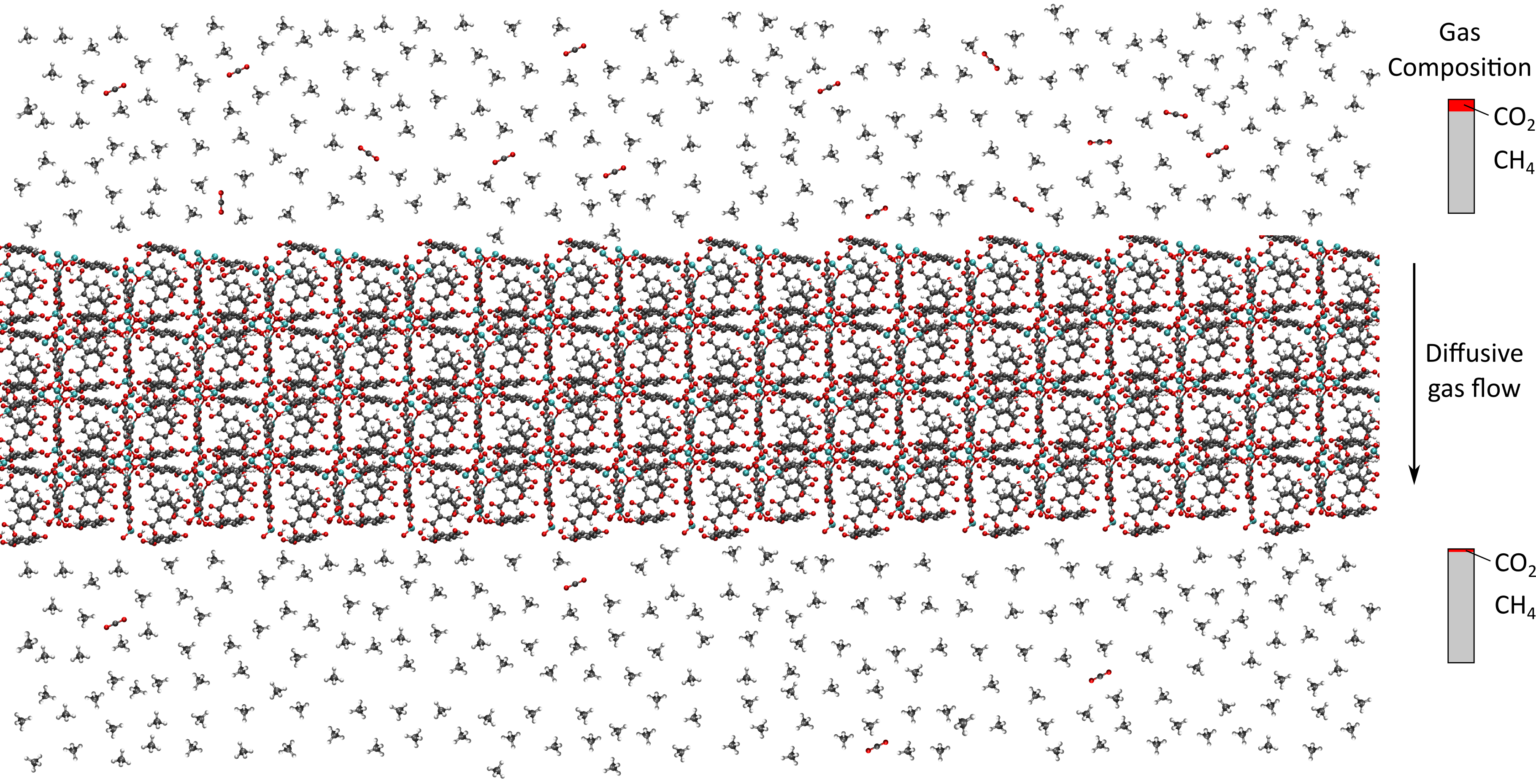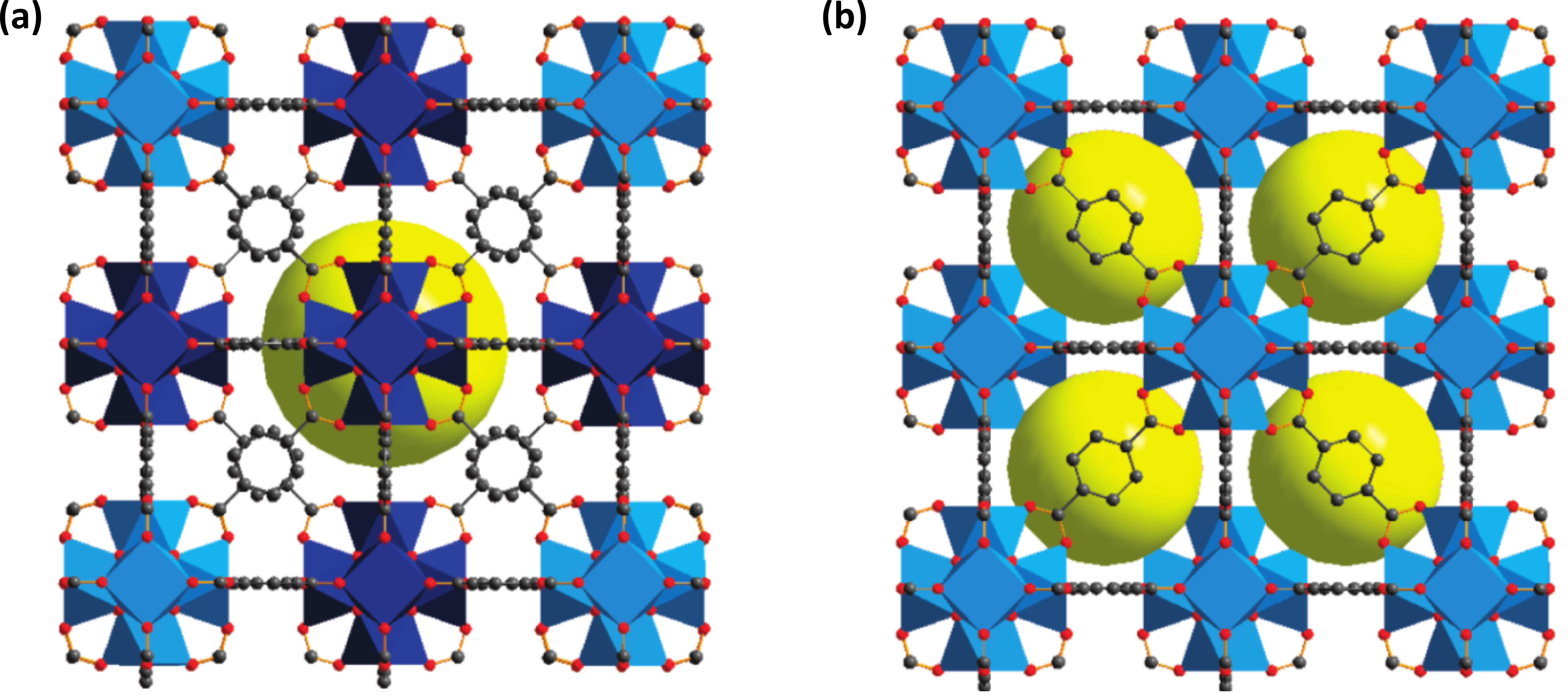Clear the way: Effect of linker defects in UiO-66 on the diffusion of CO2/CH4 mixtures
Clear the way: Effect of linker defects in UiO-66 on the diffusion of CO2/CH4 mixtures
Promotor(en): V. Van Speybroeck /16NANO14 / Nanoporous materialsMetal-organic frameworks (MOFs) are crystalline materials consisting of inorganic moieties linked by organic ligands. Besides their attracting building-block structure, they often contain nanosized pores, resulting in materials interesting for gas storage and separation, drug delivery, radioactive waste scavenging, … . Moreover, these pores also enable the selective diffusion of guest molecules, which is of particular interest for this thesis subject. Indeed, two guest molecules with different sizes or with different interactions with the host material will in general diffuse differently through the MOF. This property can be efficiently applied to upgrade raw gas flows by removing detrimental impurities. For instance, raw natural gas, which contains CH4 as its principal component, also contains traces of CO2, acting as an impurity for fuel applications. Hence, regulations stipulate that the CO2 content in natural gas should be decreased prior to transport, for instance using nanoporous membranes (see figure 1). While the structural characteristics of MOFs make them ideal candidates for this application, their limited thermal and chemical stability hampered their widespread use until a few years ago. In 2008, however, an exceptionally stable MOF, UiO-66(Zr), was synthesized, which was later found to selectively diffuse CH4 over CO2 [1]. Hence, it seems that a very viable candidate to upgrade natural gas is discovered. However, to completely understand the diffusion in UiO-66 and endorse this statement, advanced molecular simulations are of paramount importance.

Goal
In this thesis subject, diffusion of pure CH4, pure CO2 and CH4/CO2 mixtures with different ratios in UiO-66 will be studied via molecular simulations. To mimic the true diffusion of these gases in the host material, we will rely on molecular dynamics, in which the Newtonian equations of motion are integrated. It will hence be possible to follow the guest molecule microscopically, and determine the diffusion path of least resistance. This is especially interesting for UiO-66(Zr), since the material exhibits two types of pores: large octahedral pores (figure 2(a)) and smaller tetrahedral pores (figure 2(b)), which are connected through even smaller windows. Hence, the diffusion is an activated process, limited by the hopping rate between the different pores [2]. To achieve sufficiently long time scales, and hence sufficiently accurate results, intermolecular and intramolecular interactions will be described based on a force-field approach. When using force fields, the true quantum mechanical potential energy surface is approximated by an analytical expression, allowing for a fast evaluation of the atomic interactions. As a result, simulations up to a few nanoseconds are possible, which are sufficient to accurately determine the mean-squared displacement (MSD) of the guest molecule, and hence its diffusion coefficient. While an in-house force field is already derived for UiO-66, a good description of the guest-host interaction is indispensable, and will be the first topic of interest. The results of this computational study can then be compared to existing literature.

Once the diffusion in this pristine UiO-66(Zr) material is well understood, it is the aim to remove certain linkers in the MOF – creating so-called linker defects. Experimentally, UiO-66(Zr) was shown to contain a variable amount of linker defects, depending on the synthetic conditions. However, only computational studies on the pristine material are available. Hence, to bridge the gap between the experimental and computational studies, an analysis of the effect of linker defects on the diffusion of CH4/CO2 is essential. Since the introduction of linker defects merges some of the pores, it is expected that the diffusion path will be altered, and an anisotropic diffusion coefficient will be obtained. Moreover, while it was shown that addition of CO2 to the mixture increases the self-diffusivity of CH4, it is still unclear whether this is also the case for the defect materials. The final aim of this thesis is hence to quantify the effect of linker vacancies on diffusion properties, so that experimental results can be endorsed based on microscopic data for the first time.
Aspects
Physics aspect: Description of the interactions mediating the diffusion process and the selective diffusion of CH4 over CO2.
Engineering aspect: Besides the industrial relevance, the effect of linker vacancies on diffusion properties may lead to a tuning of the defects in UiO-66 to optimize the selective diffusion properties.
- Study programmeMaster of Science in Engineering Physics [EMPHYS], Master of Science in Physics and Astronomy [CMFYST]ClustersFor Engineering Physics students, this thesis is closely related to the cluster(s) NANO, MODELINGKeywordsDiffusion, Force fields, Molecular dynamics, Metal-organic frameworks, Molecular sievesReferences
[1] J. H. Cavka, S. Jakobsen, U. Olsbye, N. Guillou, C. Lamberti, S. Bordiga and K. P. Lillerud, "A new zirconium inorganic building brick forming metal organic frameworks with exceptional stability," J. Am. Chem. Soc., vol. 130, no. 42, pp. 13850-13851, 2008.
[2] Q. Yang, A. D. Wiersum, H. Jobic, V. Guillerm, C. Serre, P. L. Llewellyn and G. Maurin, "Understanding the thermodynamic and kinetic behavior of the CO2/CH4 gas mixture within the porous zirconium terephtalate UiO-66(Zr): A joint experimental and modeling approach," J. Phys. Chem. C, vol. 115, no. 28, pp. 13768-13774, 2011.


